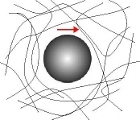
Bacterial flagellar forests for bio-enabled sensing and actuation –
In collaboration with MinJun Kim at Drexel University, we are investigating the properties of a synthetic biomaterial, the “flagellar forest”, composed of an array of bacterial flagella which are anchored to a substrate and can be actuated by a rotating magnetic field. Because flagella undergo conformational changes in response to environmental stimuli such as temperature, ionic strength, pH, and optical forcing, the goal is to create a material in which the collective response of flagella can be harnessed to actively and autonomously respond to environmental changes. We are investigating how the flagellar forest can synchronize to produce macroscopic pumping flow, and how the different polymorphic configurations of flagella affect this pumping behavior [Funded by NSF DMR-1307497.]
Image caption: Flagella patterned to a surface form a biomaterial that take advantage of flagellar response for sensing and autonomous actuation.
 The role of slip in gel microrheology –
The role of slip in gel microrheology –
In microrheology the response of a small particle is used to deduce material properties of complex media. Via analytic solutions to the motion of a sphere under oscillatory driving force in a gel, we find that slip of probe particles past the polymer network of a gel may affect rheological measurements. (Published in Phys. Rev. E [pdf].) Can slip effects be visualized in experiments?
Image caption: The response of a sphere to force depends on how easily it slides past the polymer network of a gel.

